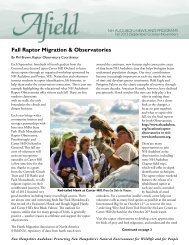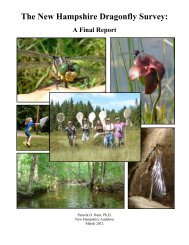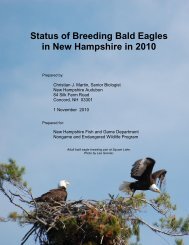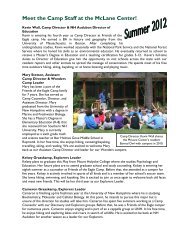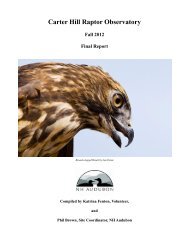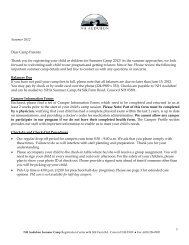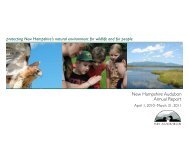2012 Annual Report - New Hampshire Audubon
2012 Annual Report - New Hampshire Audubon
2012 Annual Report - New Hampshire Audubon
- No tags were found...
You also want an ePaper? Increase the reach of your titles
YUMPU automatically turns print PDFs into web optimized ePapers that Google loves.
Expanded Counting PeriodsJust over 600 hours of observation were logged in the fall of <strong>2012</strong>, well more than the yearly averageof roughly 430 hours. The reason for the discrepancy is the expansion of the count period on eitherside of the “regular season” into the last week of August and the first half of November. The purposeof this expansion was simply to gauge the level of migratory activity before and after the traditional(and somewhat calendrically arbitrary) boundaries of September 1 and October 31. But as the data forthese additional periods cannot be compared to previous years, it has been excepted from theconclusions that follow. All statistics in this report are based on data from the traditional countperiod of September 1-October 31. However, a few things can be learned from these “early” and “late”periods.As for August: 73.5 hours of data wascollected between August 23-31, with 97total migrant raptors counted. Similar datawas collected in 2010, between August24-31, when 143 raptors were counted.Based on these two years of data, thiscount period cannot be said to bestatistically significant for any of the 10species observed. That is, in no speciesdid August birds account for more than5% of the year-end species total. The oneexception was the American Kestrel: in2010, 15 kestrels were seen in August,accounting for 6.8% of the total of 221. In<strong>2012</strong>, only 8 kestrels were seen,accounting for 4.1% of the total of 194.“Socked In”Photo by Jo-Ann MatthewsOspreys, Bald Eagles, Sharp-shinned and Broad-winged Hawks also occur in small but steady numbersin August. However, even based on this extremely limited data set, one can reasonably predict thatAugust hawk migration at Pack will not be full of surprises, nor does the available data indicate thatfurther August counting is especially warranted. As one observer noted—after hours of boredom undera hot sun—“early September is slow enough as it is.” (Foot-traffic at Miller State Park, it is worthnoting, is higher in August—an advantage for educational outreach.)November, on the other hand, is a different story. Over 77.25 hours of observation in <strong>2012</strong>, 189migrants were counted—not in itself an impressive number, but a very important one. 138 of thosebirds were Red-tailed Hawks, accounting for 26.4% of the year-end total of 522 red-tails. This is thedifference between an average, even a below-average year for the species, and an exceptionally goodone. Any reasonable sample of a species’ migratory patterns should try to take into account a period inwhich a quarter of that sample passes the observatory. This year’s data is corroborated by previousNovember observations: 102 red-tails were counted in Nov. 2010, and 160 red-tails (in just 296



